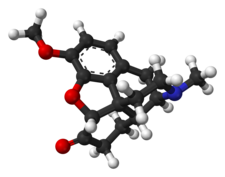User:Mr. Ibrahem/Hydrocodone
 | |
 | |
| Clinical data | |
|---|---|
| Trade names | Hysingla ER, Zohydro ER, others |
| Other names | Dihydrocodeinone, hydrocodone bitartrate |
| AHFS/Drugs.com | Monograph |
| MedlinePlus | a601006 |
| License data |
|
| Dependence liability | High[1] |
| Routes of administration | Clinical: by mouth[2] Others: intranasal, rectal |
| Drug class | Opioid[3] |
| Legal status | |
| Legal status |
|
| Pharmacokinetic data | |
| Bioavailability | By mouth: 70%[4] |
| Protein binding | Low[4][5] |
| Metabolism | Liver: CYP3A4 (major), CYP2D6 (minor)[6] |
| Metabolites | • Norhydrocodone[6] • Hydromorphone[6] • Others[6] |
| Onset of action | 10–20 minutes[2] |
| Elimination half-life | Average: 3.8 hours[7] Range: 3.3–4.4 hours[2] |
| Duration of action | 4–8 hours[2] |
| Excretion | Urine[8][9] |
| Identifiers | |
| |
| Chemical and physical data | |
| Formula | C18H21NO3 |
| Molar mass | 299.370 g·mol−1 |
| 3D model (JSmol) | |
| |
| |
| (verify) | |
Hydrocodone, sold under the brand name Hysingla among others, is an opioid used to treat severe pain of a prolonged duration, if other measures are not sufficient.[3][11] It is also used as a cough suppressant in adults.[3] It is taken by mouth.[3] Typically it is sold as the combinations acetaminophen/hydrocodone or ibuprofen/hydrocodone.[3][12] By itself it is sold in a long-acting formulation.[3]
Common side effects include dizziness, sleepiness, nausea, and constipation.[3] Serious side effects may include abuse, low blood pressure, seizures, QT prolongation, respiratory depression, and serotonin syndrome.[3] Rapidly decreasing the dose may result in opioid withdrawal.[3] Use during pregnancy or breastfeeding is generally not recommended.[13] Hydrocodone is believed to work by activating opioid receptors, mainly in the brain and spinal cord.[3] Hydrocodone 10 mg is equivalent to about 10 mg of morphine by mouth.[14]
Hydrocodone was patented in 1923, while the long-acting formulation was approved for medical use in the United States in 2013.[3][15] In the United States the wholesale cost of the long-acting formulation is about 10 to 30 USD per dose as of 2019.[16] It is most commonly prescribed in the United States, which consumed 99% of the worldwide supply as of 2010.[17] In 2017, it was the 118th most commonly prescribed medication in the United States, with more than six million prescriptions.[18][19] It is made from the opium poppy after it has been converted to codeine.[20]
References[edit]
- ^ Bonewit-West, Kathy; Hunt, Sue A.; Applegate, Edith (2012). Today's Medical Assistant: Clinical and Administrative Procedures. Elsevier Health Sciences. p. 571. ISBN 9781455701506.
- ^ a b c d Jennifer A. Elliott; Howard S. Smith (19 April 2016). Handbook of Acute Pain Management. CRC Press. pp. 79–. ISBN 978-1-4665-9635-1.
- ^ a b c d e f g h i j k l m "Hydrocodone Bitartrate Monograph for Professionals". Drugs.com. American Society of Health-System Pharmacists. Retrieved 15 April 2019.
- ^ a b Gary S. Firestein; Ralph Budd; Sherine E. Gabriel; Iain B. McInnes; James R. O'Dell (21 June 2016). Kelley and Firestein's Textbook of Rheumatology. Elsevier Health Sciences. pp. 1081–. ISBN 978-0-323-41494-4.
- ^ Bruce A. Chabner; Dan L. Longo (8 November 2010). Cancer Chemotherapy and Biotherapy: Principles and Practice. Lippincott Williams & Wilkins. pp. 700–. ISBN 978-1-60547-431-1.
- ^ a b c d Shufeng Zhou (6 April 2016). Cytochrome P450 2D6: Structure, Function, Regulation and Polymorphism. CRC Press. pp. 164–. ISBN 978-1-4665-9788-4.
- ^ Mellar P. Davis; Paul Glare; Janet Hardy (2005). Opioids in Cancer Pain. Oxford University Press. pp. 59–68. ISBN 978-0-19-852943-9.
- ^ Martin H. Bluth (16 November 2016). Toxicology and Drug Testing, An Issue of Clinics in Laboratory Medicine, E-Book. Elsevier Health Sciences. pp. 85–. ISBN 978-0-323-47795-6.
- ^ Howard S. Smith (21 February 2013). Opioid Therapy in the 21st Century. OUP USA. pp. 68–. ISBN 978-0-19-984497-5.
- ^ "WHOCC - ATC/DDD Index". www.whocc.no. Retrieved 9 September 2020.
- ^ "Hydrocodone: MedlinePlus Drug Information". medlineplus.gov. Retrieved 15 April 2019.
- ^ Briggs, Gerald G.; Freeman, Roger K.; Yaffe, Sumner J. (2011). Drugs in Pregnancy and Lactation: A Reference Guide to Fetal and Neonatal Risk. Lippincott Williams & Wilkins. p. 692. ISBN 9781608317080.
- ^ "Hydrocodone Use During Pregnancy". Drugs.com. Retrieved 15 April 2019.
- ^ "Opioid Dose Calculator". Agency Medical Directors' Group. Retrieved 15 April 2019.
- ^ Fischer, Jnos; Ganellin, C. Robin (2006). Analogue-based Drug Discovery. John Wiley & Sons. p. 526. ISBN 9783527607495.
- ^ "NADAC as of 2019-02-27". Centers for Medicare and Medicaid Services. Retrieved 3 March 2019.
- ^ "Making Some Painkillers Harder to Get". The New York Times. 21 February 2013. Retrieved 15 April 2019.
- ^ "The Top 300 of 2020". ClinCalc. Retrieved 11 April 2020.
- ^ "Hydrocodone Bitartrate - Drug Usage Statistics". ClinCalc. Retrieved 11 April 2020.
- ^ Stoker, H. Stephen (2012). General, Organic, and Biological Chemistry. Cengage Learning. p. 567. ISBN 9781133711285.
